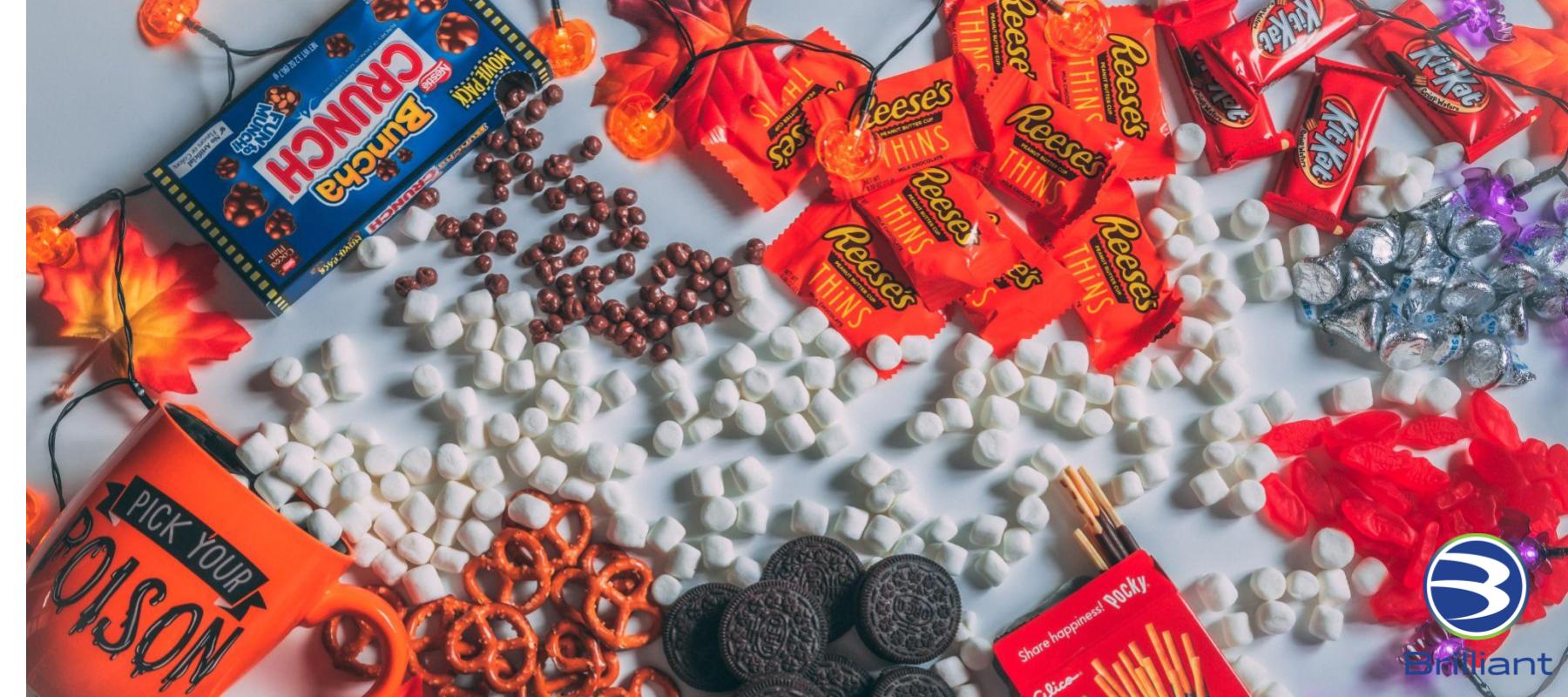- Phone: 1.404.373.4030
- Opening Hours: Mon-Fri 9AM-5PM Eastern

As we enter the fall season, we come upon Halloween, Thanksgiving, and Christmas and all the candy and sweets that go with them. What candy should parents make sure their kids avoid? Is there a good way to encourage your kids to pass up desserts for healthier foods? Our oral care specialist tackles these issues in this interview transcript of the Brilliant Choices Podcast episode, Candy And Your Teeth.
Lori
I’m interviewing Noelle Copeland, she’s a registered dental hygienist, and she’s also the oral care specialist for Brilliant Oral Care. As we all know, fall is here. This is the season of many holidays, which means a lot of food. As we approach Halloween, Thanksgiving, and Christmas, there’s going to be candy, candy, and more candy. So we’re not going to be able to totally prevent our kids from eating ANY candy. We’re going to have to let them have SOME candy; in that case, what kind of candy is not quite as bad for their teeth versus another kind?
I’m basically asking which candy is the lesser of the “evils” when it comes to sugar and our teeth?
Noelle
I have tried the approach of just no candy, at all, and it simply doesn’t work. You may think it’s working at home, like, “oh, my kids don’t eat candy, they don’t eat sugar,” and they will. Just as soon as they get older and they’re out of your reach, they’ll just eat everyone else’s candy and then they’ll consume A LOT because they realize, “ oh, my gosh, I never get this at home”. They will find themselves overdosing on mini Snickers or whatever they can get at a friend’s house. So, I don’t recommend that.
Learn from my mistakes and teach your children proper consumption to start with. That is the first thing I would say has been a kind of source of contention in my household because I started out, telling them “we’re just not eating this, we’re not eating that kind of candy because that kind of candy is really bad. Not only for your body but especially your teeth”. Honestly, there’s not any “good candy.” I mean, it all has some form of sugar, and any form of sugar isn’t good for you, no matter where it comes from. They all have pros and cons, so when it specifically comes to Halloween candy or candy that it’s getting passed out at schools and churches, it’s how much you consume that is the real problem.
In the month of October, we indulge and we go trick or treating or we will go to a festival, and my kids are allowed to collect candy, (which is the opposite of what I did when I was a kid.) When we get back home, they’ll separate their candy into categories: chocolate, gum, and fruit-flavored. They divide and organize the candy into different categories and I let them pick a piece from each category and they can eat them then. Whether it’s picking two pieces or one piece from this category or that category, they get to choose what they want the most at that point in time. The good thing about candy at this time of year is that it usually comes in mini sizes, so they aren’t getting a full-size candy bar or bag. Once Halloween is over, then we’re done with it. I’ll usually let them keep a few pieces that can come later, like in a reward situation, but I’ll hold on to them and then when they accomplish some tasks and ask if they can eat the piece of candy leftover from the event. I’ll let them have it then. Otherwise, we’re just done with candy for this season and I’ve found that works better for us. They feel like they’re getting to indulge in very typical types of sweets, but I’m limiting how much they have, so we’re not eating candy every single day from October through December.
In my opinion, there isn’t one candy that is better than another candy. What I do not like, what you should really limit is the really chewy, sticky candies. I remember last Halloween trying to eat a caramel, it felt like my jaw was going to break trying to chew through that thing. I remember thinking, “why am I still chewing this?” It probably took me five minutes to chew the entire candy. So I was imagining all that sticky sugar just getting pressed and compressed into the grooves and pits of my teeth.
When it comes to sugar, the amount of the dose is the poison. It’s the exposure to that constant feeding of the bacteria in the mouth from the sugar. So the sticky, gummy, and chewy things are the more high-risk candies for cavities, especially if it doesn’t get washed out of the teeth. The best advice is to steer clear from the sticky, gummy, really chewy sweets.
Lori
What can we do? Should we brush their teeth immediately after having the candy? What’s the best thing to do once the sugar is there? What’s the best process to do after they eat it?
Noelle
Yes, oral care needs to happen after eating candy and I’m a huge proponent of xylitol. Actually, xylitol is a sugar substitute as a sugar alcohol. What xylitol does when you use it in toothpaste or in a mouth rinse, is it prevents the bacteria that are in the mouth, the pathogenic bacteria that naturally lives there but has the potential to grow out of control if it’s fed too many sugars, (if you keep feeding to the beast, it’s gonna grow), Xylitol prevents the bacteria from sticking to the teeth. The bacteria is trying to set up shop on the tooth and collect all the sugar and plaque and then it’s just like building this house on the tooth. Xylitol prevents that bacteria from sticking to the tooth, so it just slides off the tooth and goes down the back of the throat.
*That is a process that helps prevent tooth decay from starting but it also helps the pH of the mouth. It brings the pH of the mouth back to that more alkaline place where you don’t want it to be too acidic. High fructose corn syrup and types of sugar are going to make the mouth more acidic. That’s why after you have candy you just feel like your mouth is dry and you need water. When you have a candy bar or something that’s just really rich, you get thirsty and that’s why, because it dries out your mouth.
Lori
Okay, so everyone should definitely brush their teeth after having sugar, and you mentioned one of the best things to use is xylitol. Doesn’t Brilliant Oral Care have a tooth gel that contains xylitol?
Noelle
Yes, we do have tooth gel that includes xylitol, we have our strawberry banana flavor which is kind of marketed as a kids toothpaste, but I use it and I love the taste. It’s not an overbearing strawberry banana flavor, very mild in taste, just has a slight fruitiness to it. We also have a plain flavor, which I’ve found appeals to a lot of my special needs and cancer patients. They really appreciate that plain, no flavor gel because they don’t have to deal with an extra sensation of flavors for them that could be an aversion to cleaning teeth.
Lori
It’s good that there is an alternative for those that need one. As a parent who has been through this numerous times, how can we, especially at this time of year around all these different holidays that literally revolve around food, how can we try to encourage our kids to skip the dessert table or the candy bag and head towards the more healthy food? Is there a good way to do that, and is that even possible?
Noelle
You know, it’s really dependent on the child. As I’m learning with my three kids, I’m struggling the most with one of them in particular, but I educate them all the same way. We talk about it together, consistently. At school, my kids are currently eating school lunch, and we look at the menu and we’ll see something like yogurt or chocolate milk versus plain milk. I’ll say to them, “I would rather you choose plain, white milk rather than chocolate milk,” and I explain to them why. And then I let them make the choice for themselves. Of course, I ask them what they chose and they are usually really proud to tell me, “ we got this and that, and we didn’t get the chocolate milk, we got this other one.” I’m giving them the information in a positive way, and I’m constantly talking about making better choices. Now sometimes, yes, we’re going to indulge. We’re going to have a double scoop of ice cream with sprinkles and chocolate, but then that’s our treat for the week and the rest of the week, we make better food choices.
So, I’m giving them the opportunity to make better choices. They will tell me though when they make a different choice that I would not make, and then they realize they didn’t actually like that sweet thing like they thought they would. And so, that has been the benefit of reducing our sugar consumption on a regular basis and their taste buds acclimate to that. Because they’re not
getting processed, highly refined sugar and chemically treated sugar on a regular basis, they have developed the taste for a much lower concentration of sugar. When my seven-year-old did choose the yogurt option at school for lunch because she didn’t like what the other options were, she was amazed at how sweet the yogurt tasted. She couldn’t even eat it because it tasted so sweet. So, that’s how I know it’s working, our process for dealing with sugar. In America, highly refined and processed sugar is just a recent addition to the diet. It’s not something that’s present in the world naturally, other than honey from a honeybee. When you consume this highly refined, highly processed form of sugar, it stimulates the taste buds in your mouth and on your tongue. It’s a very complex process that activates your brain and your motor responses, it stimulates dopamine, which is perceived as very highly rewarding. It is actually the same way that people get addicted to drugs, that dopamine release. You have the surge, you like it, then it makes you want to consume it again and again.
It’s that highly refined, high percentage of sugar that you’re gonna find in pretty much anything that’s on the shelf in the grocery store. If it’s not a natural form of sugar coming from a fruit or vegetable, potatoes, or anything that has natural sugar, and if it’s on the shelf or in a box, it’s very highly processed. Even if it’s made with sugar substitutes, sugar alcohol is still processed and it still has preservatives. In fact, sugar is used as a preservative in so many things, you need to be reading your cereal ingredients, the ingredients in your crackers, your soup, peanut butter, and reading every single label of what you buy. If you turn that label over to read, there are so many different words and forms for sugar, I think people would be really surprised if you just Google different names for sugar. Then you will see just how much sugar is in these items that you really never knew was actually sugar.
Lori
Yes, sugar has become an epidemic honestly because it is in everything these days, and until you actually take the time to stop and read the labels of what you’re buying or what you’re thinking about buying at the grocery store, you don’t know the seriousness of it. When you see how many grams of sugar are per serving, not per box but per serving, it is absolutely mind-blowing. Obviously, we’re talking about your oral health and we know it’s not good for your teeth, but it’s not good for any part of your body either.
Noelle
Growing up as a child, our rewards system was pretty much always food. Something great happens, let’s go out to eat, you did something good, here’s a treat. I’m a foodie and I love the celebratory social aspect of a meal with friends and family. I like going out and celebrating with a meal, but I’ve tried to really check myself on rewarding my kids with food or treats. something and then they want something. So just being creative and coming up with things other than food rewards is key. My fourteen-year-old, I can take to look for makeup. My younger two like doing art projects, so I can take them to the arts and craft stores.
Lori
Yes, we do that as well. Mine are too old now to go for toys or stickers. So we start with rewards, here’s $5. Let’s put it away, here’s $10. Let’s put it away. And when they’ve earned enough money, we can go get an Amazon gift card and they can look and order things that they’ve been wanting. We save up for it. So that’s kind of how we do the rewards around here. I try to steer away from food rewards as well. Now when it’s birthdays or holiday celebrations, you can’t avoid sugar all the time.
Hopefully, we’ve been able to help some parents out there when it comes to sugar and our kids, its effect on their teeth, and their overall health. Enjoy the holidays and always keep the healthy options on the table!
This interview is also featured on our Brilliant Choices Podcast which is available on Apple Podcasts and Spotify, and you can also link to those on our website under Brilliant Choices Blog, as well as our social media pages. We have good topics related to what’s going on with you, your family, and your oral care needs.
https://open.spotify.com/show/3moUh9SnljUxih9PhNNbrN
© 2021 Compac Industries. All rights reserved.
This article is intended to provide an understanding of and knowledge about “health topics” as expressed through the perspective and research of the author. It is not intended to be a substitute for professional advice or counsel, including the diagnosis or treatment of any condition. Always seek the advice of your qualified healthcare provider with any questions you may have regarding a medical condition, illness or treatment of any listed or non listed situation above. By using this site, you signify your assent to our Terms and Conditions.
Noelle Copeland RDH is an Oral Care Specialist and Dental Consultant who provides content for Brilliant Oral Care and Baby Buddy.


DISCLOSURE: Noelle Copeland RDH is an Oral Care Specialist and Dental Consultant who provides content

DISCLOSURE: Noelle Copeland RDH is an Oral Care Specialist and Dental Consultant who provides content

We believe that all people are fearfully and wonderfully made and designed in the womb for a grand purpose.
Useful Links
Copyright © 2023 Compac Industries | All Rights Reserved.